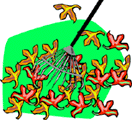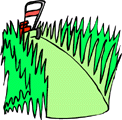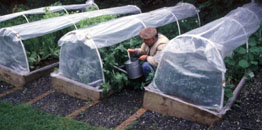
Compost Happens!
Tips for composting in any
climate, especially cool ones
By Marion Owen, Fearless Weeder
for PlanTea, Inc. and
Co-author of Chicken Soup for the Gardener's Soul
FEATURE ARTICLE:

Tom Hanks' "Power of Four" solution
More good stuff:
Who is Marion Owen?
FAQs about PlanTea
Search Marion's articles, tips and recipes
Why grow organic?
News and press releases
Read love letters
How to link to this site
Need a speaker?
How to contact Marion
Visiting Alaska?
Come to Kodiak Island!
Go to home page

Marion's UpBeet Gardener
Newsletter has been
replaced by Marion's blog
which you can find at:
www.marionowen.wordpress.com
Making compost is like baking
a cake!
 My neighbor, Mrs. Crayneck, loves to bake. But when her world famous
banana bread doesn't turn out quite right, she doesn't sweat the small
stuff.
My neighbor, Mrs. Crayneck, loves to bake. But when her world famous
banana bread doesn't turn out quite right, she doesn't sweat the small
stuff.
"What's the worst thing that can happen?" she says. "I
just put it in the compost pile!"
Sooner or later gardeners come across the word "compost." As easy as it
is to say, compost has a reputation for being difficult to master. Yet
nothing could be further from the truth. If I can make hot, 160-degree
compost during an Alaska winter (see photo below), you can too--no matter
where you grow your tomatoes. It's easy. In fact, you can compost
163 materials! Here's how, beginning with a story about my Mom...
"If you can read, you can cook!"
One day, when I was 12 and still climbing trees, Mom came into the kitchen and said, "Honey, how about making dessert for tonight?"
Having just endured months of salad-making for our family of seven, I was ready for a change. Mom picked up an old copy of Gourmet cookbook and started flipping through the pages. It was like watching Wheel of Fortune.
 Finally,
she pressed her finger to a recipe and said, "Here you go, make this."
Finally,
she pressed her finger to a recipe and said, "Here you go, make this."
Her finger pointed to a chocolate souffle recipe. I was stunned. "Don't worry sweetie," she said. "If you can read, you can cook."
So began my love affair with cooking. I also learned a valuable lesson: You can do whatever you set your mind to, but if you need help in building a house, installing software, or making compost -- follow a recipe!
Let's begin this lesson by de-mystifying compost. We'll make it easier by following a recipe. And as you'll see, making a compost pile is a lot like making a cake. And we can do it in 3 easy steps. 1) Gather up your ingredients, 2) Stir them together, and 3) let it cook. Even Bette Midler knows the value of compost...
Why the Divine "Miss M" loves compost
|
"My whole
life has been spent waiting for an epiphany, a manifestation
of God's presence, the kind of transcendent, magical experience
that lets you see your place in the big picture. And that is
what I had with my first compost heap. I love compost and I
believe that composting can save not the entire world, but a
good portion of it." |
I'm sure Bette Midler would agree that making and using compost is not
only a life-changing experience, but it's the world's best soil conditioner.
- Compost recycles organic materials, from apple cores and coffee grounds, to dried leaves and Shredded Wheat.
- Compost improves any, and all, soil types.
- Compost provides the basic nutrients of nitrogen (N), phosphorus (P), and potassium (K) as well as dozens of micro- and macro nutrients that are vital for healthy plants.
- Compost "gives back" nutrients that flowers, herbs and vegetables remove in their normal growth processes.
- Compost prevents nutrients from leaching away from plant roots.
- Compost protects soil against wind and rain erosion, drought, dust storms, earthquakes and other extreme conditions.
- Compost extends the life of landfills by reducing space needed for food and yard wastes.
The "compost cake" recipe
Did you know you can have finished compost in just 3 to 4 weeks? By combining the right ingredients, your compost pile will not only heat up to 140 degrees (F) or more, but it will "cook down" to a fluffy material that is ready to use in the garden.
Step 1: Collect your compost ingredients
For a hot, active compost pile, you need to build it all at once, not over weeks or months. Imagine making a cake by sifting the flour one day, adding eggs and oil the next and then waiting a week or so before mixing everything together and getting it into the oven. It would be a flop. Start collecting ingredients. Go on organic treasure hunts. Talk to your neighbors, ask your friends, scan the classified ads, and remember to check your own back yard.

Did you know the hair on your head contains 30 times more nitrogen
than manure? Next time you go to the hairdresser, ask for a few pounds
of this nitrogen gold mine to add to your compost.
You're looking for a combination of ingredients that will provide the right living conditions for the microorganisms and bacteria that break down the materials in the compost pile. This tiny work force of actimomycetes (act-TIN-OH-my-SEE-tees) must have food, water and oxygen to do their job. They need nitrogen (N) in order to use the carbohydrates or carbon (C) materials as food.
|
"Without the microorganisms at work in compost, soil would literally be dead." --Eleanore Perenyi, from "Green Thoughts: A Writer in the Garden" |
Therefore, you want to try for a nitrogen (N) to carbon (C) ratio of about
1 to 3.

Produce trimmings are good sources
of Nitrogen (N).
What about putting URINE in the compost pile?
Do it. According to wikipedia, the online encyclopedia, urine is sterile and contains large amounts of urea, an excellent source of nitrogen for plants. Recommended dilution: 10-15 parts water to 1 part urine for application growing season. Urine is also a good source of phosphorus and potassium, and is widely considered as good as or better than commercially-available chemical fertilizers. Urine is also used in composting to increase the nitrogen content of the mulch, accelerating the composting process and increasing its final nutrient values. |
Carbon (C) materials include: Straw, dried leaves, sawdust (in small
amounts), wood chips (also in small amounts), and shredded newspaper,
cardboard and brown bags. One of the best and easiest combinations to
come by occurs in the fall. Mix 3 parts dried leaves to 1 part green grass
clippings to make a compost that is light, airy and fine. Now that's gourmet!


Gourmet compost: 3 parts leaves + 1 part grass clippings.
Materials you DON'T want to add to a compost pile include: meat scraps, oily products such as salad dressings, peanut butter and mayonnaise, pet litter and food, branches and other large woody materials, slick magazine pages, and waxed cardboard.
If you live near a coastal community, kelp and seaweed is a must-have ingredient. Here on Kodiak Island, kelp piles on the beaches in long windrows, and is available to anyone with a truck or garbage can. Pound per pound, kelp supplies more minerals than any other material on the planet. In the garden, it also aerates the soil and makes an excellent mulch around potato plants, fruit-bearing shrubs, bulbs and perennials. And, contrary to popular belief, seaweed does not add harmful salts to the garden.
Kelp is what I call a "neutral" ingredient, in that it doesn't fit in the nitrogen or the carbon category. Yet, it benefits every compost pile by adding fluff. So, if you live in North Dakota, either make a pilgrimage to the coast or invite your beach buddies to come visit with their suitcases packed with seaweed.

To learn more about compost ingredients and composting, check out the list of books, websites and other resources listed at the end of this article.
Step #2: Stir your compost ingredients
Once you assemble your ingredients, you're ready to build your compost pile. Here are some basic guidelines:- Work with a minimum size of 3x3x5 feet. (If you live in a milder climate, then 3x3x3 feet is large enough). The key is to make a compost pile large enough to retain heat and prevent ingredients from drying out. Expect temperatures of 120 to 160 degrees (F), which is enough to kill most weed seeds and pests.
- Use an enclosure, either ready-built, or one make of heavy wire screen, wood pallets, etc.
- Coarse materials should be chopped or shredded.
- Build the pile in layers, like a cake, alternating nitrogen and carbon materials.
- Hose down the layers with water. The ingredients should feel like a damp sponge.
Step #3: Let your compost cook
Turn the pile every 4 to 7 days to aerate it and to provide the microorganisms with fresh food. With tumblers, simply give it a spin occasionally. For bin enclosures, use a pitchfork to turn the pile, moving the inside materials to the outside, and the outside materials to the inside--just like folding cake batter. This is a good upper body workout.
How do you know when the compost is done?The compost pile is done cooking when it no longer warms up within a few days of turning it. Incidentally, the pile will shrink to about half of its original size.
|
Roses
are red, violets are blue. |
Troubleshooting the compost pile
Problem: The compost pile doesn't
get very hot, even though it has enough materials.
Possible Solution: You might need
to add more nitrogen ingredients such as green grass clippings or manure
to correct the nitrogen to carbon ratio. Make sure the ingredients are
damp. Too dry, and they won't start cooking.
Problem: The compost heap heats
up and cools down like it's supposed to, but a lot of the materials are
large and not broken down.
Possible Solution: Because the
materials are big and chunky, they don't provide enough surface area for
the microorganisms to finish their work. Chop the materials as best you
can. A Crocodile Dundee knife, or machete, works great for this.
Problem: Whew, the compost pile
has a strong odor.
Possible Solution: The pile is
undergoing what's called "anaerobic decomposition." Anaerobic means "without
oxygen" which is why it smells like the beach at low tide. You need to
add introduce oxygen back into the pile by turning it at least once a
week.
Problem: Animals on the loose!
Possible Solution: If dogs, mice,
rats, cats or raccoons are getting into to your compost pile, fence it
in, cover it with wire and avoid adding meat scraps, bones, and fish waste
to the pile.
|
Roses
are red, violets are blue. |
How to use compost
- Apply a 4 to 6-inch layer of compost-mulch around woody perennials in the fall to reduce damage from winter winds.
- After the soil has warmed up in the spring, apply compost around warm season vegetable crops such as zucchini and tomatoes.
- Spread compost on the garden a couple weeks before spring tilling.
- Add compost to container gardens, hanging baskets
- During the growing season, side-dress your plants with compost to provide a slow-release source of nutrients.
- Make compost tea. Add a shovelful of compost to a 5-gallon bucket of water and allowing it to steep for a few days. For larger quantities, add compost to a 55-gallon drum. Use the nutrient-rich tea to fertilize lawns, shrubs, perennials, containers, hanging baskets, as well as annual vegetables, herbs, and flowers. Dilute the tea for younger plants.

Adding compost tea to raised beds, Juneau, Alaska.
- Apply a 1 to 2-inch thick mulch around flowers, trees and shrubs in the spring to maintain soil moisture and discourage weed growth.
- Use compost as a growing medium for seedlings and potted plants. After screening out large particles, you'll need to pasteurize it before using it.
For more information about compost, compost bins, and more:
- "The Rodale Book of Composting" by Deborah L. Martin (Editor), Grace Gershuny (Editor)
- "Let It Rot : The Gardener's Guide to Composting" (Storey's Down-To-Earth Guides) by Stu Campbell.
- "Easy Composting," by Vic Sussman, Rodale Press, Inc.
- "39 Easy Composters You Can Build" by Nick Noyes (Paperback) October 1995.
- Innovative Uses for Compost by the U.S. Environmental Protection Agency.
- Master Composter A "master composter" site which includes sources for everything from bins to worms; recycled products and more.
- www.organicgardening.com A place to bookmark for all your organic gardening questions.
- Seattle Public Utilites' compost page An excellent resource for the home composter.
- Seattle Tilth Organic Gardening--Urban Ecology--Composting--Recycling. Highly Recommended.

Thanks for visiting and please stop by again. I'll put the coffee on!
Meet Marion Owen /// Learn about PlanTea /// Online Catalog /// Articles, Tips, Recipes /// Get free UpBeet Gardener newsletter /// Read current issue /// Listen to radio show /// Read news and press releases /// More resources and links /// Learn why 'grow organic?' /// View guidelines for retailers /// Read love letters /// Book Marion as a speaker /// Site map /// How to link to us /// Contact us /// Go to home page
PlanTea: The organic plant food in tea bags. http://www.plantea.com
Copyright �1996 to present: PlanTea, Inc. All Rights Reserved. PO Box 1980, Kodiak, AK 99615-1980 USA
Questions or comments? marion@plantea.com Phone: Toll Free: 1-800-253-6331 (US and Canada); 907-486-2500